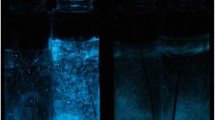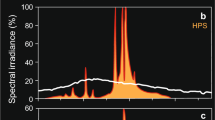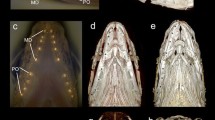Abstract
The “burglar alarm” theory of bioluminescence was investigated by determining predation rates of a nocturnal teleost predator, Porichthys notatus, on nonluminescent kelp mysids illuminated by dinoflagellate flashes, between the fall and spring of 1989/1990. Mysids (Holmesimysis costata) were placed in aquaria containing varying concentrations (0 to 40 cells/ml) of the dinoflagellate Pyrocystis fusiformis and a single midshipman fish. Controls used P. fusiformis during their luminescence-inhibited day phase. Mysid swimming movements readily stimulated dinoflagellate luminescence. Flashes and prey strikes were observed simultaneously by image-intensifying and infrared video cameras on a splitscreen monitor. Predation rates increased at dinoflagellate concentrations of 3 to 15 cells/ml and decreased below controls at levels>20 cells/ml. Videotape analysis showed that at low concentrations (2 to 5 cells/ml), strike success rates exceeded 75% if prey were previously illuminated by a flash, but dropped below 50% at higher cell densities. Increased predation was attributed to luminescence revealing prey position. The decrease at higher concentrations was considered to be due to greater flash frequency providing a more diffuse and confusing target. The study demonstrates the effects of secondary luminescence on zooplankton predation at normally encountered dinoflagellate concentrations.
Similar content being viewed by others

Literature cited
Buck, J. B. (1978). Functions and evolutions of bioluminescence. In: Herring, P. J. (ed.) Bioluminescence in action. Academic Press, London, p. 419–460
Burkenroad, M. D. (1943). A possible function of bioluminescence. J. mar. Res. 5: 161–164
Buskey, E., Mills, L., Swift, E. (1983). The effects of dinoflagellate bioluminescence on the swimming behavior of a marine copepod. Limnol. Oceanogr. 28: 575–579
Easias, W. E., Curl, H. C., Jr. (1972). Effect of dinoflagellate bioluminescence on copepod ingestion rates. Limnol. Oceanogr. 17: 901–906
Guillard, R. R. L., Ryther, J. H. (1962). Studies of marine planktonic diatoms. I. Cyclotella nana (Hustedt) and Detonula confervacea (Cleve) Gran. Can. J. Microbiol. 8: 229–239
Hobson, E. S., McFarland, W. N., Chess, J. R. (1981). Crepuscular and nocturnal activities of Californian nearshore fishes, with consideration of their scotopic visual pigments and the photic environment. Fish. Bull. U.S. 79: 1–30
McAllister, D. E. (1961). A collection of oceanic fishes from off British Columbia with a discussion of the evolution of black peritoneum. Bull. natn. Mus. Can. 172: 39–43
Mensinger, A. F., Case, J. F. (1989). Relationship between bioluminescence and vision in the midshipman, Porichthys notatus. Am. Zool. 29: p. 67 A
Morin, J. G. (1983). Coastal bioluminescence: patterns and functions. Bull. mar. Sci. 33: 787–817
Tett, P. B., Kelly, M. G. (1973). Marine bioluminescence. Oceanogr. mar. Biol. A. Rev. 11: 89–173
White, H. H. (1979). Effects of dinoflagellate bioluminescence on the ingestion rates of herbivorous zooplankton. J. exp. mar. Biol. Ecol. 36: 217–224
Widder, E. A., Case, J. F. (1982). Luminescent microsource activity in bioluminescence of the dinoflagellate, Pyrocystis fusiformis. J. comp. Physiol. 145: 517–527
Author information
Authors and Affiliations
Additional information
Communicated by J. M. Lawrence, Tampa
Rights and permissions
About this article
Cite this article
Mesinger, A.F., Case, J.F. Dinoflagellate luminescence increases susceptibility of zooplankton to teleost predation. Mar. Biol. 112, 207–210 (1992). https://doi.org/10.1007/BF00702463
Accepted:
Published:
Issue Date:
DOI: https://doi.org/10.1007/BF00702463



